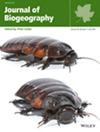Eurasian drylands are both evolutionary cradles and museums of Nitrariaceae diversity
Abstract
Aim
Drylands cover about 41% of Earth's land surface and are home to fragile biota with high levels of endemism. Two hypothetical models, i.e., cradle and museum, have been proposed to account for present-day species diversity in an ecoregion or biome. We investigated macroevolutionary patterns to test these two different models in Nitrariaceae, a characteristic component of the Eurasian dryland ecosystem. We also used this family to explore the intercontinental disjunct distribution pattern between the deserts of Eurasia and western North America, known as the Madrean–Tethyan disjunction.
Location
Drylands in the Northern Hemisphere.
Taxon
Nitrariaceae (Sapindales, Angiosperms).
Method
We sampled all 16 of the currently recognized extant species of Nitrariaceae and 59 species from the eight other families of Sapindales. A fossil-calibrated phylogeny was generated using 12 fossil constraints. The ancestral range and climate niche of Nitrariaceae were reconstructed, and diversification rates were estimated.
Results
The most recent common ancestor of Nitrariaceae likely inhabited arid habitats with low rainfall in the temperate zone in the Late Cretaceous, which geographically corresponds to present-day Central Asia. The western North American Peganum mexicanum split from its Central Asian sister group at approximately 39 Ma. Net diversification rates of Nitrariaceae experienced a significant increase around 11 Ma. Within Sapindales, at least seven arid species originated markedly prior to the Miocene.
Main Conclusions
The North Atlantic land bridge and global cooling climate in the Late Eocene might have driven the formation of the present-day disjunct distribution of Nitrariaceae between arid Central Asia and western North America. Nitrariaceae originated in the Late Cretaceous and exhibited long-term climate niche conservatism, but experienced a rapid diversification in the late Miocene of Eurasia in response to orogenetic and climatic changes. These findings suggest that Eurasian drylands serve as both evolutionary cradles and museums for the diversity of Nitrariaceae and likely for other arid-adapted lineages.

 求助内容:
求助内容: 应助结果提醒方式:
应助结果提醒方式:


